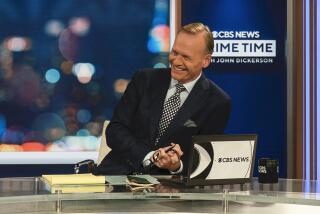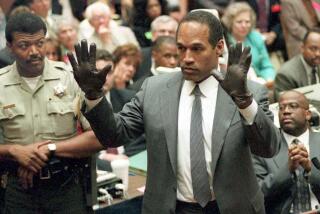3 KCBS Chiefs Analyze TV News
- Share via
NO TWO VIEWERS see their evening anchors in quite the same way. No two local newscasts are produced or presented in quite the same way. And no two news executives use the same criteria for deciding what to put on the tube. Even their definitions of the basics vary. Channel 2’s chief news executives gave these responses, recently, to three questions about TV news.
ROBERT HYLAND III, general manager: “TV news is information. God, this is a tough one. How do I say this to you? It affects the viewers’ current situation as well as their life. Their future. Their family. Their total environment. You’ve got to look at it as the dissemination of the information to the viewer that helps them deal with their world. . . . It also affords an opportunity for viewers to be more curious about their world, to want to know more about their lives. It introduces them to issues they can affect, too. It could be zoning or schools or transportation, anything where the tax dollars that they pay influence events that relate to their lives.”
MICHAEL SINGER, managing editor: “At its best, television news is a medium to convey basically headlines of the day’s events with pictures and to give people a visceral sense, rather than an intellectual sense, of what the news of the day is. What it can do best is record a process, which print really can’t do. But the two should never be thought of as supplements for each other. They complement each other. When TV news is at its best, when it is visually and journalistically on the mark, it has a kind of impact on people that is quite extraordinary.”
ERIK SORENSON, news director: “I think television news is a majority of the public’s favorite way to get news because it’s compressed, it’s fast and it’s one form of news that takes people right to the story, both with pictures and sound. So, in my mind, it’s the best way to get news until Max Headroom becomes real.”
sources of news?
HYLAND--”Obviously, with a newspaper, you can put it down and read it anytime you want. With TV news, you the viewer are exposed to many different kinds of subjects in a short period of time. You are receiving this information as it’s coming at you across the screen, but later maybe you want to know more. But you can’t get it from TV because of the short period of time given to, say, the weather, or maybe the place where you live. What a TV broadcast can do is make you curious and allow you to go to other sources of information.”
SINGER--”It is, more than any other kind of news, a sharp turnaround medium. In other words, what TV can do is give you a sense of an event while it is going on. And that has its advantages and its disadvantages. The great disadvantage is that you don’t have a lot of time as a journalist to think about the context of the event, the meaning of the event, the relationship of the event to other events. But the advantage is that, if you believe people should be informed (quickly), then TV can deliver in a way no other news medium can.”
SORENSON--”It takes people to the scene. The viewer-reader only has one shot to get the message with television, but you can always reread a newspaper article. . . . The Jessica McClure story was much better if you see her coming out of the ground than if you read it the next morning in the New York Times. On the other hand, with the nuclear disarmament issue, even MacNeil-Lehrer couldn’t compete with the morning newspaper.”
HYLAND--”If you look at it from the point of view of income, age, occupation, it’s basically everybody. There’s no one you’re segmenting your news for.”
SINGER--”I touch base with all kinds of people across the spectrum, and it seems to me that all kinds of people watch TV. The real evidence of that is that this country was profoundly changed by the civil-rights movement and the Vietnam War, and those events could not have changed this country without television news. An incredibly wide array of people watched and were changed by it. It is incumbent on us to be responsible to them, and that isn’t easy these days.”
SORENSON--”I think everybody watches at one time or another. . . . However, I think the regular viewers of TV news--the majority--tend to be people who are a little less mobile, maybe because they are less affluent or just can’t get around the way they used to. That seems to be the bulk of our audience. They are somewhat sedentary. They may not be very educated, but they’re very sophisticated, and I think we in television news tend to underestimate (them).”
More to Read
The complete guide to home viewing
Get Screen Gab for everything about the TV shows and streaming movies everyone’s talking about.
You may occasionally receive promotional content from the Los Angeles Times.






